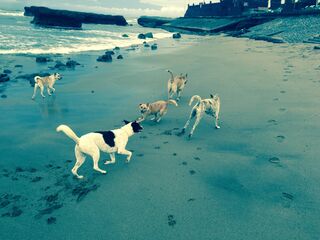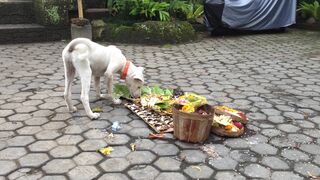Relationships
Science and Speculation Say Dogs Would Do Well Without Us
What would a planet without humans look like and how would dogs fare?
Posted October 21, 2021 Reviewed by Lybi Ma

What would happen to dogs if humans disappeared? In A Dog's World: Imagining the Lives of Dogs in a World Without Humans, Jessica Pierce and I imagine a posthuman future for dogs and argue they would survive―and possibly even thrive―without us. We base our arguments on what we know about the diverse nature of dogs and dog-human relationships, evolutionary biology, and behavioral ecology and explore who dogs might become without direct human intervention into breeding, arranging playdates, feeding, and providing veterinary care.
Because dogs are a very diverse species―there is no universal dog and around 75 percent of the billion or so dogs on Earth already are free-ranging or feral―and also are quick learners who are highly adaptable and opportunistic, we argue that many dogs already survive on their own and they and others could do so without us.1 There's also a tendency for people to overplay their importance to their dog's well-being.
Because dogs descended from wolves, we also must appreciate that ancient impulses and memory traces still lurk in their brains, and these indelible engrams still influence what they do and how they feel, and likely will shape how they do without us. Dogs still have access to wolf memories and share wolf genes and even as different forms of natural selection replace human (artificial) selection in which our desires trump natural selection, we can expect that some wolf traits will surface from time to time.
The shape of the future: Body size, food, sex, care-giving, sociality, cognitive capacities, and emotional intelligence
When dogs go wild, not only will they have to provide for themselves and other dogs if they form groups, but they also will become members of wild communities as they rewild, reshape, redecorate, and recreate a wide variety of ecosystems. They'll have to cooperate, coexist, or compete with other individuals―what we call the 3 C's―and these relationships will surely change over time depending on who the dogs are, who else is around, and the nature of the habitats―the diverse posthuman landscapes―in which they live.
Here are a few facts about the fate and life-history traits of posthuman dogs.2
Size: When we asked people how dogs would do without us, many instantly said, "Large dogs will do better than small dogs." However, this isn't necessarily so, as small dogs might not be seen as competitors by other carnivores and they also may be able to outrun them and hide in places where these competitors might not fit. Small dogs also won't have the caloric needs that larger dogs will have. Of course, large dogs will be more likely to compete with large predators, but there are downsides to being large. In our discussion of morphology, we also consider skulls, eyes, ears, tails, and coats.
Food. Posthuman dogs will have to search for, find, and consume food on their own or as members of a pack. Without food, they'll die.

Although feral and some free-ranging dogs aren't directly dependent on humans for feeding, many rely almost entirely on anthropogenic (human) food resources such as human waste, garbage dumps, and handouts for survival. Dogs also are cursorial mammals ("runners")―they're born to run―and this will help them procure food.
We argue that many posthuman dogs will be able to get what they need to balance caloric costs and will develop the social and physical skills including the aerobic and anaerobic fitness they'll need to fulfill their nutrition requirments. Forming and maintaining packs in which individuals cooperate and coordinate their activities should be no problem at all.

Sex. Without reproducing, dogs will peter out. Data show that dogs on their own will be able to flirt, court, and attract mates, copulate, find or make dens, and produce viable children.3 They'll also be able to provide parental care and there also might be helpers―aunts, uncles, older siblings, and others―who will provide what is called alloparental care. Data on free-ranging and feral dogs support this claim. It's also interesting to speculate if female dogs on their own will go from having two periods of heat a year to one as wolves have.
Sociality. Sociality is the tendency of animals to form groups and live together in organized ways. We argue that some posthuman dogs will live in loose groups, some will live in cohesive packs of various sizes that might resemble wolf packs, and some will likely live alone. They'll also show similar patterns of space use as do wolves and other carnivores and form similar relationships with other species with whom they share space and the resources contained in these areas. With adequate parental care, pups will become socialized and accustomed to their posthuman worlds.
The inner lives of posthuman dogs. Some of the canine capacities that might be most relevant to their future survival include the ability to rapidly process information, learn new skills, solve problems without succumbing to frustration, assess risk, and accurately read the intentions and emotions of others. After reviewing the literature on the cognitive, emotional, and moral lives of current dogs and their wild relatives, we show that posthuman dogs have all of the necessary skills to negotiate new environments and the ecological challenges they'll face. They also will possess the emotional intelligence they'll need to deal with the wide variety of social situations they'll encounter and we'll see the same variations in behavioral flexibility and individual personalities we now see in current dogs. Because they share a similar language of play, they'll also enjoy playing fairly with one another and perhaps with individuals of other species.
Many posthuman dogs will do just fine without us
All in all, the evolutionary trajectories of posthuman dogs will suit many of them quite well. It's important to stress three things, namely: dogs will not de-domesticate and go back to being wolves, but rather they will undergo feralization; we shouldn't look to Chernobyl to get an idea of how posthuman dogs will do because these dogs actually have a good deal of human support (also see); and because only around 25 percent of dogs are "intensively homed"―essentially living in captivity―and controlled by us, we need to be very careful about using them as the template for answers to how dogs will do without us. It's essential to study free-ranging and feral dogs to get a better handle on the fate of posthuman dogs.
It's clear there are few hard-and-fast answers to the many questions about how posthuman dogs will fare without us. We look forward to critical discussions about what they'll face and how they'll do without our mingling in their lives. We argue that many will do just fine.
References
1) In our book we use "free-ranging" or "feral" rather than "homeless" because estimates for different classes of dogs are hugely variable depending on the criteria that are used. And, our conclusions do not depend on numbers, but rather on the experiences of individual dogs both before and after we're gone.
2) Four chapters in our book include discussions of a number of biological/evolutionary, morphological (the shape and form of animals), and behavioral topics. Our Table. 3.1, called “Ecological and evolutionary trajectories of posthuman dogs," lists them all. Biologists typically haven’t traditionally done life-history analyses of dogs or other domesticated animals because these animals have been considered artifacts who weren’t subjected to natural selection and who thus haven’t evolved trade-offs among life-history traits. Nonetheless, we argue that dogs, along with other domesticated animals, do have life histories, have made necessary trade-offs, and are worthy of study. The life-history strategies of dogs reflect the ways in which humans have deliberately manipulated trade-offs among different variables to suit human interests; they also reflect the fact that humans don't actually exert as much control as we think.
3) Dogs possessing what we call genetic "malware" that prohibits them from breeding or giving birth without human intervention clearly will not make it in a posthuman future.
Barash, David. ‘A Dog’s World’ Review: When the Pug Joins the Pack. Wall Street Journal, 21 October 2021.
Bekoff, Marc.
Dog-Human Relationships From the Dog's Point of View.
'Stray': The Fascinating Lives of Free-Ranging Turkish Dogs.
Why It's Important (and Fun) to Study Free-Running Dogs.
Personality Traits of Companion and Free-Ranging Bali Dogs.
(New research shows free-ranging dogs are less active, excitable, and aggressive.)
Muinde, Patrick et al. Who let the dogs out? Exploring the spatial ecology of free-roaming domestic dogs in western Kenya. Ecology and Evolution, March 2021.
Pierce, Jessica and Marc Bekoff. Home Alone: The Fate of Post-Pandemic Dogs. Scientific American, October 26, 2021.
_____ and _____. Imagining the Lives of Dogs in a World Without Humans. Town Hall Seattle, October 26, 2021.
Spitznagel, Eric. Why dogs might actually be better off without humans, New York Post, October 23, 3021.
Spotte, Stephen. Societies of Wolves and Free-ranging Dogs. Cambridge University Press, 2012.




